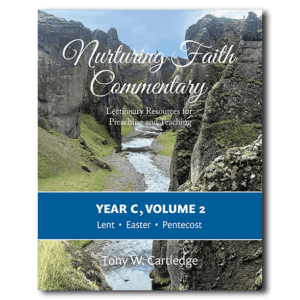
Editor’s note: “Look Back” is a series designed to highlight articles from the Good Faith Media archives that remain relevant or historically interesting. If you have an article from our archives that you’d like us to consider including in this series, please email your suggestion to submissions@goodfaithmedia.org. A version of this article previously appeared at EthicsDaily.com on May 26, 2008.
As a child, I wasn’t aware that Memorial Day observances were intended for those felled on the battlefield.
I thought of it as a day of family remembrance, honoring relatives gone before us – veterans and non-veterans alike – something akin to a low-church All Saints Day – but with flowers, lots of flowers.
For decades, one of my uncles in southern Oklahoma assumed the duty of trimming grass, pulling weeds and placing wreaths on the Rowell, Sehested and Young burial plots in the small town of Marlow, where I was born and where my own name is carved – with only a birthday for now – in a granite slab that marks the grave of my father.
Decorating the graves of fallen soldiers goes back at least to the fifth century BCE, when the Athenian leader Pericles offered tribute over the graves of Peloponnesian War casualties. In the United States, however, the tradition originally referred to as “Decoration Day” sprang up in response to the Civil War.
Where the first such commemoration was held is murky. Boalsburg, Pennsylvania, Vicksburg, Mississippi, Waterloo, New York, and Carbondale, Illinois, all make the claim (along with some 20 other cities). It wasn’t until 1966 that a Congressional resolution formally recognized the village of Waterloo as “the first observance of Memorial Day as a national holiday.”
Most such observances were in April or May when plenty of flowers were available. Not surprisingly, women primarily were the ones who took the initiative.
Even the first national leader to issue a proclamation marking the day – for May 30, 1868 – Gen, John A. Logan, commander in chief of the Grand Army of the Republic, was said to have been inspired by his wife’s account of viewing women decorating the graves of Confederate soldiers in Petersburg, Virginia.
Two years earlier the New York Tribune printed a story of women in Columbus, Mississippi, laying flowers on the graves of both Confederate and Union soldiers.
Decoration Day ceremonies were often occasions for a renewal of bitter regional rivalries. In Arlington Cemetery, Confederate and Union gravesites were segregated from each other, and in some years, soldiers prevented people from decorating the graves of Confederates.
In New York, the first state to declare May 30 a holiday, Confederate veterans were not allowed to parade with their flag or uniforms.
In the South during Reconstruction, Decoration Day provided a rallying point for continued resistance to the Civil War’s conclusion and the occupying Union troops.
In other northern cities, the occasion featured diatribes against freed slaves and abolitionists. Rarely, if ever, was the day devoted to celebrating the emancipation of slaves.
Contrary to popular opinion, most Unionists were not abolitionists. In fact, the most deadly race riot in U.S. history was in July 1863 in New York City, after President Lincoln signed legislation ordering a military draft.
For five days, poorer white residents – mostly Irish, then New England’s “white trash” – looted and burned, targeting mostly African Americans, including an orphanage. In the end, there were at least 120 fatalities and over 2,000 wounded.
“Freeing the slaves” was not a widespread motive for the war. Lincoln himself wrote: “I am not, nor ever have been in favor of bringing about in any way the social and political equality of the white and black races.” In the lines of a popular rhyme in northern cities when the war broke out, “To the flag we are pledged, all its foes we abhor. And we ain’t for the nigger, but we are for the war.”
Other interesting facts about the holiday:
- Shortly after the war’s end, some 10,000 freed slaves in Charleston, South Carolina, dedicated a cemetery holding the remains of Union prisoners of war.
- Nine former Confederate states still have an official “Confederate Memorial Day.”
- A 1905 story in The New York Times reported that a two-year-old mystery had finally been solved. It involved the repeated decoration of a tall granite shaft in a Westchester, New York, cemetery commemorating the deaths of Confederate soldiers. The Daughters of the Confederacy claimed the wreaths had not been their doing. As it turns out, two Unionist women’s organizations had been secretly placing the memorial flowers. “Although the services yesterday were nominally intended to honor the Confederate dead,” wrote the journalist, “the graves of Union soldiers had the highest heap of flowers on them, and they were put there by the Southern women.”
The current Memorial Day holiday observance, placing the date on the last Monday of May, was not established by Congress until January 1971.
It’s hard to comprehend the devastation of the U.S. Civil War. The official death toll of 620,000 soldiers (civilian casualties were not tallied) – almost equal the death toll of all subsequent U.S. wars – represented 2% of the population. Two percent of our nation’s current population comes to more than six million.
A reported conversation following World War I between Woodrow Wilson of the United States, David Lloyd-George of Great Britain and Georges Clemenceau of France speak well to the situation under consideration.
Among them it was asked, “Do we want peace?” Their agreed answer was, “Yes.”
Then it was asked, more probingly, “Are we willing to abandon colonialism?” And the British answered, “No, of course not.”
It was further asked, “Are we willing to forgo any claims for reparation against the Germans?” This time it was the French and the Americans who said, “No.”
Then, within that influential threesome, the perceptive insight was voiced, “What we really want is not peace, but only quiet while we enjoy the spoils of our victory in war.”
To say it more concisely: We all want peace, but we also want what we cannot get without war – which is why it’s not enough to be for peace.





